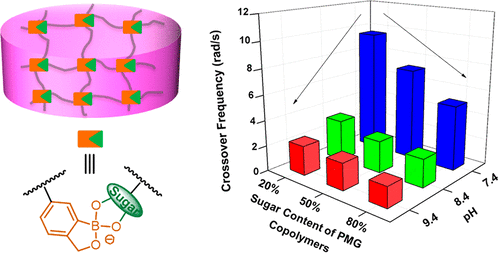当前位置:
X-MOL 学术
›
Biomacromolecules
›
论文详情
Our official English website, www.x-mol.net, welcomes your
feedback! (Note: you will need to create a separate account there.)
Injectable Self-Healing Zwitterionic Hydrogels Based on Dynamic Benzoxaborole–Sugar Interactions with Tunable Mechanical Properties
Biomacromolecules ( IF 5.5 ) Pub Date : 2018-01-27 00:00:00 , DOI: 10.1021/acs.biomac.7b01679 Yangjun Chen 1 , Wenda Wang 1 , Di Wu 2 , Masanori Nagao 3 , Dennis G. Hall 2 , Thomas Thundat 1 , Ravin Narain 1
Biomacromolecules ( IF 5.5 ) Pub Date : 2018-01-27 00:00:00 , DOI: 10.1021/acs.biomac.7b01679 Yangjun Chen 1 , Wenda Wang 1 , Di Wu 2 , Masanori Nagao 3 , Dennis G. Hall 2 , Thomas Thundat 1 , Ravin Narain 1
Affiliation

|
Dynamic hydrogels based on arylboronic esters have been considered as ideal platforms for biomedical applications given their self-healing and injectable characteristics. However, there still exist some critical issues that need to be addressed or improved, including hydrogel biocompatibility, physiological usability, and tunability of mechanical properties. Here, two kinds of phospholipid bioinspired MPC copolymers, one is zwitterionic copolymer (PMB) containing a fixed 15 mol % of benzoxaborole (pKa ≈ 7.2) groups and the other is zwitterionic glycopolymers (PMG) with varied ratios of sugar groups (20%, 50%, 80%), were synthesized respectively via one-pot facile reversible addition–fragmentation chain transfer (RAFT) polymerization. PMBG hydrogels were formed spontaneously after mixing 10 wt % of PMB and PMG copolymer solutions because of dynamic benzoxaborole–sugar interactions. The mechanical properties of nine hydrogels (3 × 3) with different sugar contents and pHs (7.4, 8.4, 9.4) were carefully studied by rheological measurements, and hydrogels with higher sugar content and higher pH were found to have higher strength. Moreover, similar to other arylboronic ester-based hydrogels, PMBG hydrogels possessed not only self-healing and injectable properties but also pH/sugar responsiveness. Additionally, in vitro cytotoxicity tests of gel extracts on both normal and cancer cells further confirmed the excellent biocompatibility of the hydrogels, which should be ascribed to the biomimetic nature of phosphorylcholine (PC) and sugar residues of the copolymers. Consequently, the zwitterionic dynamic hydrogels provide promising future for diverse biomedical applications.
中文翻译:

基于可调节机械性能的动态苯并氧杂硼酸酯与糖相互作用的可注射的自修复两性离子水凝胶
基于芳基硼酸酯的动态水凝胶具有自我修复和可注射的特性,因此被认为是生物医学应用的理想平台。但是,仍然存在一些需要解决或改进的关键问题,包括水凝胶的生物相容性,生理可用性和机械性能的可调性。在这里,有两种磷脂生物启发的MPC共聚物,一种是两性离子共聚物(PMB),其中含有固定的15 mol%的苯并氧杂硼酸酯(p K a≈7.2)个基团,另一个是具有不同糖基比率(20%,50%,80%)的两性离子糖聚合物(PMG),它们是通过一锅便捷的可逆加成-断裂链转移(RAFT)聚合反应合成的。由于动态苯并氧杂硼酸酯与糖之间的相互作用,在混合10 wt%的PMB和PMG共聚物溶液后,会自发形成PMBG水凝胶。通过流变学方法仔细研究了九种不同糖含量和pH(7.4、8.4、9.4)的水凝胶(3×3)的机械性能,发现具有更高糖含量和pH的水凝胶具有更高的强度。而且,类似于其他基于芳基硼酸酯的水凝胶,PMBG水凝胶不仅具有自我修复和可注射的特性,而且还具有pH /糖响应性。此外,在体外凝胶提取物对正常细胞和癌细胞的细胞毒性测试进一步证实了水凝胶的优异生物相容性,这应归因于磷酸胆碱(PC)的仿生性质和共聚物的糖残基。因此,两性离子动态水凝胶为各种生物医学应用提供了有希望的未来。
更新日期:2018-01-27
中文翻译:

基于可调节机械性能的动态苯并氧杂硼酸酯与糖相互作用的可注射的自修复两性离子水凝胶
基于芳基硼酸酯的动态水凝胶具有自我修复和可注射的特性,因此被认为是生物医学应用的理想平台。但是,仍然存在一些需要解决或改进的关键问题,包括水凝胶的生物相容性,生理可用性和机械性能的可调性。在这里,有两种磷脂生物启发的MPC共聚物,一种是两性离子共聚物(PMB),其中含有固定的15 mol%的苯并氧杂硼酸酯(p K a≈7.2)个基团,另一个是具有不同糖基比率(20%,50%,80%)的两性离子糖聚合物(PMG),它们是通过一锅便捷的可逆加成-断裂链转移(RAFT)聚合反应合成的。由于动态苯并氧杂硼酸酯与糖之间的相互作用,在混合10 wt%的PMB和PMG共聚物溶液后,会自发形成PMBG水凝胶。通过流变学方法仔细研究了九种不同糖含量和pH(7.4、8.4、9.4)的水凝胶(3×3)的机械性能,发现具有更高糖含量和pH的水凝胶具有更高的强度。而且,类似于其他基于芳基硼酸酯的水凝胶,PMBG水凝胶不仅具有自我修复和可注射的特性,而且还具有pH /糖响应性。此外,在体外凝胶提取物对正常细胞和癌细胞的细胞毒性测试进一步证实了水凝胶的优异生物相容性,这应归因于磷酸胆碱(PC)的仿生性质和共聚物的糖残基。因此,两性离子动态水凝胶为各种生物医学应用提供了有希望的未来。


















































 京公网安备 11010802027423号
京公网安备 11010802027423号